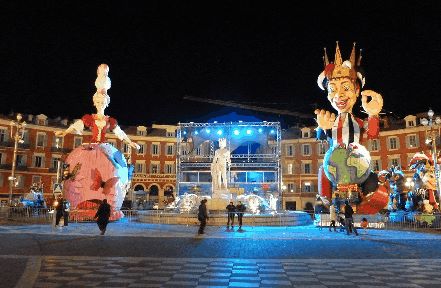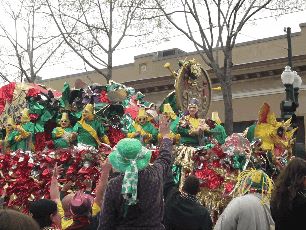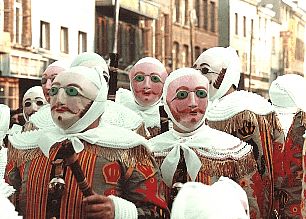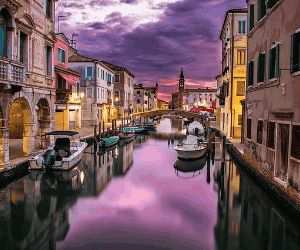
|
France There are two major Carnivals of France, one in the city of Nice and the other in the capital city of Paris. The Paris Carnival dates back to the 16th century or earlier and traditionally occurs after the Feast of Fools. At the heart of it is the working class, with butchers, traders and police among the multi-class participants. There are two major events of the modern Carnival of Paris. The first is the walk of masks in which a huge number of people disguise themselves and meet at a specific place and time for other to see their creativeness. The other events are the various processions for different groups, with the largest being the Promenade du Boeuf Gras ("Procession of the Fat Ox"). The Carnival of Nice dates back to 1294, and is one of the world's major carnival events, along with the ones of Brazil and Venice. It began from pagan celebrations and has grown to a huge annual twelve day party. During this time, the city is filled with parades of floats, street events and stalls selling food, gifts, lavender and brightly colored fabrics.  The King and Queen of carnival of Nice, France at Masséna place This Carnival starts off with a huge parade containing about twenty floats that travel through the streets. Each year, the theme of the parade changes and the floats are made to match the theme. Joining the floats are around fifty giant puppets, grosses tetes ("big heads"), which are made of paper glued together and painted in flamboyant colors. These giant heads often weigh over 2 metric tons and are 8 to 12 metres high. "King Carnival" is one of these giant creations and leads the parade. Another major part of the Carnival of Nice is the Bataille de Fleurs ("Battle of Flowers"). This originally started back in 1856 to entertain the tourists that had begun to visit the south of France. During this, a parade of floats covered in flowers travels the streets, with people on them and walking along side them tossing out various kinds of flowers to the crowds. The "battle" aspect comes from the onlookers competing to get the flowers, often being men trying to get the best flowers to present to their lovers. Around 100,000 fresh-cut flowers are used, with about 80% of them produced locally. The parade ends at Place Massena, where King Carnival is burnt on the last night. This is followed by a huge fireworks display over the Baie des Anges ("Bay of Angels"). United States & Mardi Gras Carnival is also celebrated in different places in the United States, but there it is often called Mardi Gras. Mardi Gras is French for "Fat Tuesday", which refers to the tradition of eating richer, fatty foods. Mardi Gras refers particularly to the last day, but over time it has grown to be the name for the entire festival. It came to the states as part of the French Catholic tradition when France set up colonies in the south during the 17th century.  At one of the parades, New Orleans Mardi Gras There are Mardi Gras festivals all over the United States in many states, including California, Alabama, Florida, Michigan, Mississippi, Missouri, Oklahoma, Pennsylvania, Texas, Wisconsin and Louisiana. Of these, the festival of Louisiana's capital, New Orleans, is the largest and best known. There, the celebrations last about two weeks, with a major parade occurring on most days. Some of these days have several large parades. The largest and most elaborate of these parades take place in the final days of the Festival, along with many events, both large and small, occurring throughout New Orleans. The parades are organized by Carnival krewes. Krewe float riders toss items, known collectively as throws, to the crowds. Throws are normally strings of colourful beds, wooden coins, and small toys. In order to get attention and get more throws, people often expose certain body parts. This activity, known as flashing, is discouraged by the police, and doing so can get a person arrested or ticketed. More Bizarre? Carnival is celebrated in some form in over 50 countries. These include most of the European countries, Cape Verde Islands and Seychelles in Africa, Indonesia, India, Israel and Japan in Asia, and most of the countries of North and South America. It would be impossible to examine even a fraction of them in the space of this article. Most of these involve people dressing up and participating in various parades and processions. There are a few more bizarre versions of the celebration that are not as well known.  Gilles wearing their masks in Binche, Belgium The Carnival of Oruro, Bolivia, is over 2000 year old and mixes native rituals with the Catholic event. Oruro was once a major mining town, so part of the celebration is a religious ceremony in honor of the Virgin of the Mineshaft. Another part is the Diablada, or "dance of the devils", in which people dress up as demons and dance in the streets along with some dressed as angels, representing good conquering evil and the seven deadly sins. In Binche, Belgium, they have one of the oldest street carnivals in Europe. The main figures in this Carnival are called Gilles. Hundreds of men wear costumes with the colors of the Belgium flag and are covered in strange crests, tassels and bells. The Gilles wear wooden clogs on their feet and strange masks on their faces which have curled moustaches and large green glasses. The costumes are also stuffed with straw to give the men a much bulkier look. The Gilles dance down the streets with baskets full of blood oranges, which they hurl at onlookers. No one is exactly sure of the meaning of the Gilles. The shoes might be used to stomp away the winter and the masks to represent equality among everyone, similar to the masks of Venice. The oranges are considered to be a gift from the Gilles, but sometimes they have caused property damage. Learn More You probably have some kind of Carnival festivals in your country, even if you don't know about them already. Since we can't explore all the various forms of this celebration, try to learn about them and compare them to what you have read here, or research other versions in different countries. Have fun! |
| Celebrations - Carnival | ||||||||||||||||||||||||||||
| Writer: | Sonja Krüger | |||||||||||||||||||||||||||
| Images: | ||||||||||||||||||||||||||||
| ||||||||||||||||||||||||||||
| Sources: | ||||||||||||||||||||||||||||
| ||||||||||||||||||||||||||||
All images are Copyright - CC BY-SA (Creative Commons Share Alike) by their respective owners, except for Petey, which is Public Domain (PD) or unless otherwise noted.
comments powered by Disqus



















